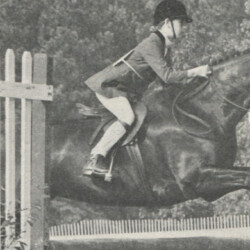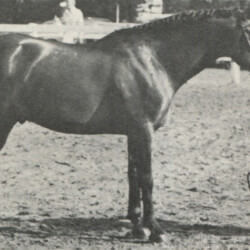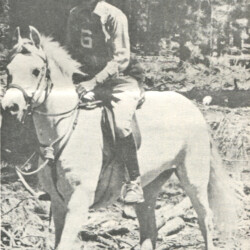1975 Autumn Issue: Connemara Awards Suggested; ACPS Applies for ASHA Recognition of Connemaras
The 1975 Autumn Issue (Vol. 5, No. 3) of the American Connemara Pony Society News was 12 pages.
Secretary Betty O’Brien said in her update that two members had proposed the society establish a Connemara of the Year award. Each thought the award should be determined by accumulated show points. This would be separate from High Score awards in the AHSA (now USEF). The ACPS was pursuing becoming an AHSA recognized breed.
O’Brien said perhaps such an award could include trail mounts, eventing ponies, driving ponies and breeding stock.
Request for AHSA recognition
On AHSA recognition, this newsletter included the letter that Ann Gascoyne submitted to James H. Blackwell, executive secretary of the AHSA, as the ACPS requested that the Connemara be a recognized breed.
In the letter, Gascoyne made the case for why Connemaras were growing in significance. She described horse shows with Connemara divisions (Woodstock and Elmira) or classes (she said numerous shows had classes). She also noted that Connemaras were winning in open competition and listed many of those ponies.
She provided some stats, including that:
— There were 76 Connemara breeders of purebred Connemaras in the US.
— The largest breeder (presumably Al Mavis of Oak Hill Farm in Rochester, Illinois) had 300 ponies and produced 50 to 60 foals a year, which she said were all purebred but not all registered.
— At the time, the purebred registered totals were 892 mares, 376 stallions, and 270 geldings.
And she mentioned standout Connemaras Dundrum, Little Model, Little Squire and Stroller, plus eventing phenoms St. Finbarr and Grasshopper.
There was nothing in the newsletter to indicate whether the AHSA had responded.
Annual meeting news
News about upcoming meetings included Dorothy Lyons’ suggestion that the ACPS meeting the following year, in 1976, be held in conjunction with the Olympic Games in Montreal, with the ACPS turning the meeting into an international conference. Mary Bailey of Lynfields Farm in Vermont was appointed chairman. Organizers had found a place for everyone to stay during the Olympics at a new ski lodge in the Jay Peak area of northern Vermont. Tickets for the equestrian events were sold out, but ACPS officials were hoping more would be made available.
The ACPS’ annual fall meeting for the current year, 1975, was set for Nov. 15 in Kansas City, Missouri, in conjunction with the American Royal Horse Show.
The meeting’s agenda was to focus on horse shows, with the following items to be discussed:
— Type of horse shows preferred.
— Preferred competition for Connemaras: eventing, pleasure, jumping, hunter, dressage, trail riding, etc.
— Recommended Connemara judges.
— Members not in good standing, use of AHSA terms, breed show point of view.
— Possible regional stars to be sent to one big breed show for national championship (I don’t think that happened).
— Report on plans for international conference.
Photos
See the gallery below for the photos.
A photo of Dieudonnee Boldun from Woodstock in 1973 said he was 2-year-old champion in hand at Woodstock after being yearling champion the previous year. He was owned by Mrs. John Grew Jr. of Dieudonnee Farm in West Newbury, Massachusetts.
A photo of Hideaway’s Erin Tooreen, owned by Indian Hill Ranch in Valley Center, California, was accompanied by information from owner Pat Barbee. She said Erin Tooreen was the winner of the Connemara class at that year’s Channel City Horse Show in Santa Barbara, California. He also was currently leading North San Diego County in points for English Pleasure and Hunter and Jumper divisions.
A photo of Rose Hill’s Mr. B (by Georgia’s Mister Irish), ridden by 10-year-old Kimberly Hackett, included info that the child did not know how to ride in 1974, when the Hacketts bought “B,” but had advanced in a year to 4-H State Reserve Champion in Georgia and a “C” Pony Clubber with a regional rally under her belt (the Atlanta Pony Club was third out of seven, Kim and B had the second highest score on the team, and Kim was the youngest at the rally by four years). The pair were fourth on the Georgia Hunter-Jumper Association list in 12-and-under equitation. They had two championships and one reserve.
A photo of Dr. Marian Molthan riding OH Heather Buck’s Roan on a North American Trail Ride Conference ride, an endurance ride, said Doc achieved third place in Region III on the basis of five rides and placed fifth in horsemanship, lightweight division.
A photo of child rider Mary Ann Burgess, of Amherst, New Hampshire, on Round Robin’s Andante, purchased in 1973, said the pair was leading the state of New Hampshire in equitation 14 and under.
A photo of Dorothy Lyons, dressed as George Washington, showed her riding her stallion, Bar Bar A’s Kilkerrin Paddy, in Santa Barbara’s Fourth of July parade.
Deaths
Two deaths were reported by Mildred C. Young of Hitching Post Farm in Greenville, South Carolina, for foundation mares Winter Mollie and Glencara Hope.
*Winter Mollie, by Creganna Winter out of Cnocmordain Lass, was imported by Whitewood Stud and subsequently owned by William F. Lovell of Charlotte, North Carolina, and Young. The mare had 15 registered foals.
*Glencara Hope by Dun Lorenzo out of Hope Gill, similarly was imported by Whitewood Stud and then owned by Lovell and Young. The mare had 13 foals
Neither death notice was accompanied by a photo.
Also, the newsletter discussed the ongoing lack of registration of foals and lack of TFCs being registered permanently. The section included a note that the society was seeking help with “reporting of deaths and the return of such certificates to this office.”
Subsequent newsletters reveal that the society was asking for members to send back the certificate of ownership of deceased Connemaras. We would never part with our certificates. Not sure why the ACPS sought their return.
New members
There was a section that welcomed and named new members.
Region news
A section on news from the regions included horse show results. If I were to pick out a theme, it would be disappointment with attendance or Connemara activity.
New England reported lower attendance for its Connemara Division at the Woodstock show. New York reported few entries, but improved quality, in the Connemara classes at Elmira.
North Central — reported by Ann Gascoyne, so I’m going to assume this included Kentucky — discussed a poorly attended regional meeting, though six Connemaras competed at shows. The area had four stallions when Gascoyne surveyed region members a year earlier.
Gascoyne, who seemed to be heading the society’s efforts to join the AHSA, made an interesting point on conducting her survey that I will quote in full:
“I had hoped by getting this information and passing it on in our region, we might become more aware and strengthen our knowledge to help promote the breed. It is my hope that other regional chairmen might do the same. There are huge gaps in information on what Connemara ponies and their owners are doing (shows, Pony Club, hunting, eventing, etc.). We need to know these things in order to become recognized by the American Horse Shows Association and to help create promotional information and simply to answer letters of inquiry about Connemaras.“
We agree. Conducting ongoing surveys of members is good, as is sharing data about the ACPS.
Lower Mississippi Valley had no meeting and was looking at participating in a Welsh show.
The Pacific Southwest, written by Dorothy Lyons, summarized what her horses had been doing, as well as those of Dr. Marian Molthan, MD, and Pat Barbee.
There was a note on an upcoming trail ride across the United States as part of the 200th anniversary of the US. The Bicentennial Trail Ride (eventually called The Great American Horse Race) was billed as a three-month ride starting in June 1976 (it started on the last day of May). The entry fee was $500, and first prize was $100,000 (it wound up being $25,000), with proportional prizes for other finishers. Each rider would take two horses, riding one horse and ponying the other. They would travel a marked course 60 miles long in 14 hours each day. Riders would be timed out and in. Support crew would be provided for every three riders. The competitors would ride six days, then rest one. A farrier would be provided. Later newsletters reveal that Dr. Marian Molthan competed in the ride with her own mare, OH Heather Buck’s Roan, and Dorothy Lyons’ Spring Ledge Bridgette. More on that in subsequent issues.
Gallery
Click a photo to enlarge it.






